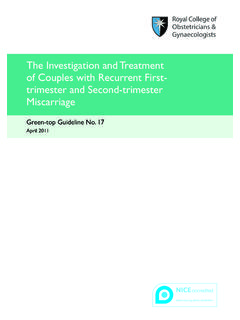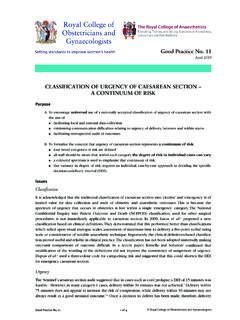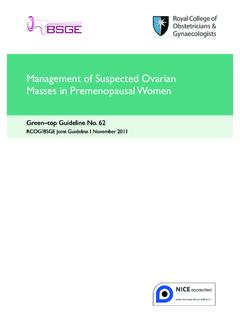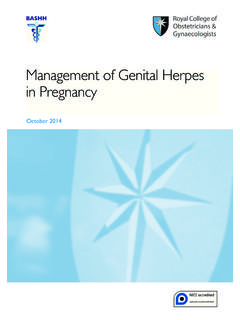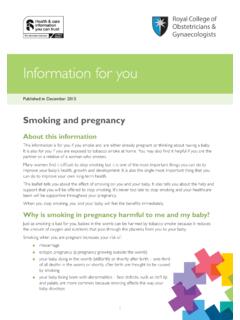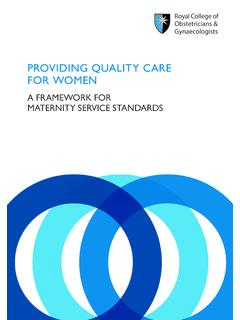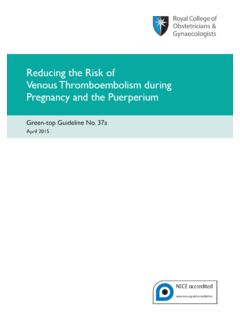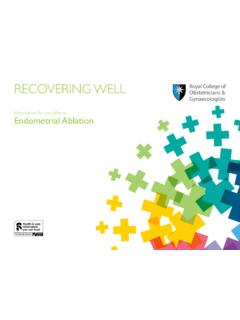Transcription of The Management of Gestational Trophoblastic Disease
1 The Management of Gestational Trophoblastic DiseaseGreen top Guideline No. 38 February 2010 RCOG Green-top Guideline No. 382 of 12 Royal College of Obstetricians and Gynaecologists 2010 The Management of Gestational Trophoblastic DiseaseThis is the third edition of this guideline. It replaces The Management of Gestational Trophoblastic Neoplasia,which was published in Trophoblastic Disease (GTD) forms a group of disorders spanning the conditions of complete andpartial molar pregnancies through to the malignant conditions of invasive mole, choriocarcinoma and the veryrare placental site Trophoblastic tumour (PSTT). There are reports of neoplastic transformation of atypicalplacental site nodules to placental site Trophoblastic there is any evidence of persistence of GTD, most commonly defined as a persistent elevation of beta humanchorionic gonadotrophin ( hCG), the condition is referred to as Gestational Trophoblastic neoplasia (GTN).
2 And scopeThe purpose of this guideline is to describe the presentation, Management , treatment and follow-up of GTDand GTN. It also provides advice on future pregnancy outcomes and the use of and introductionMolar pregnancies can be subdivided into complete (CM) and partial moles (PM) based on genetic andhistopathological features. Complete moles are diploid and androgenic in origin, with no evidence of fetaltissue. Complete moles usually (75 80%) arise as a consequence of duplication of a single sperm followingfertilisation of an empty ovum. Some complete moles (20 25%) can arise after dispermic fertilisation of an empty ovum. Partial moles are usually (90%) triploid in origin, with two sets of paternal haploid genes andone set of maternal haploid genes.
3 Partial moles occur, in almost all cases, following dispermic fertilisation ofan ovum. Ten percent of partial moles represent tetraploid or mosaic conceptions. In a partial mole, there isusually evidence of a fetus or fetal red blood (hydatidiform mole, invasive mole, choriocarcinoma, placental-site Trophoblastic tumour) is a rare eventin the UK, with a calculated incidence of 1/714 live is evidence of ethnic variation in theincidence of GTD in the UK, with women from Asia having a higher incidence compared with non-Asianwomen (1/387 versus 1/752 live births). However, these figures may under represent the true incidence ofthe Disease because of problems with reporting, particularly in regard to partial moles.
4 GTN may develop after a molar pregnancy, a non-molar pregnancy or a live birth. The incidence after a live birth is estimated at1/50 000. Because of the rarity of the problem, an average consultant obstetrician and gynaecologist may dealwith only one new case of molar pregnancy every second the UK, there exists an effective registration and treatment programme. The programme has achievedimpressive results, with high cure (98 100%) and low (5 8%) chemotherapy and assessment of evidenceThis RCOG guideline was developed in accordance with standard methodology for producing RCOG Green-top Guidelines. Medline, Embase, the Cochrane Database of Systematic Reviews, the Cochrane ControlRegister of Controlled Trials (CENTRAL), the Database of Abstracts of Reviews and Effects (DARE), theAmerican College of Physicians ACP Journal Club and Ovid database, including in-process and other non-indexed citations, were searched using the terms molar pregnancy , hydatidiform mole , gestationaltrophoblastic Disease , Gestational neoplasms , placental site Trophoblastic tumour , invasive mole , choriocarcinoma and limited to humans and English language.
5 The date of the last search was July Green-top Guideline No. 383of 12 Royal College of Obstetricians and Gynaecologists 2010 Selection of articles for analysis and review was then made based on the relevance to the objectives. Furtherdocuments were obtained by the use of free text terms and hand searches. The National Library for Healthand the National Guidelines Clearing House were also searched for relevant guidelines and level of evidence and the grade of the recommendations used in this guideline originate from theguidance by the Scottish Intercollegiate Guidelines Network Grading Review Group, which incorporatesformal assessment of the methodological quality, quantity, consistency and applicability of the evidence to the rarity of the condition, there are no randomised controlled trials comparing interventions withthe exception of first-line chemotherapy for low risk GTN.
6 There are a large number of case control studies,case series and case do molar pregnancies present to the clinician?Clinicians need to be aware of the symptoms and signs of molar pregnancy: The classic features of molar pregnancy are irregular vaginal bleeding, hyperemesis, excessiveuterine enlargement and early failed pregnancy. Clinicians should check a urine pregnancy test in women presenting with such presentations include hyperthyroidism, early onset pre-eclampsia or abdominal distensiondue to theca lutein cysts. Very rarely, women can present with acute respiratory failure orneurological symptoms such as seizures; these are likely to be due to metastatic are molar pregnancies diagnosed?Ultrasound examination is helpful in making a pre-evacuation diagnosis but the definitive diagnosis ismade by histological examination of the products of use of ultrasound in early pregnancy has probably led to the earlier diagnosis of molarpregnancy.
7 Soto-Wright et al. demonstrated a reduction in the mean gestation at presentation from16 weeks, during the time period 1965 75, to 12 weeks between 1988 majority ofhistologically proven complete moles are associated with an ultrasound diagnosis of delayedmiscarriage or anembryonic ,4In one study, the accuracy of pre-evacuation diagnosis ofmolar pregnancy increased with increasing Gestational age, 35 40 % before 14 weeks increasing to60% after 14 further study suggested a 56% detection rate for ultrasound ultrasound diagnosis of a partial molar pregnancy is more complex; the finding of multiple softmarkers, including both cystic spaces in the placenta and a ratio of transverse to anterioposteriordimension of the gestation sac of greater than , is required for the reliable diagnosis of a partialmolar ,7 Estimation of hCG levels may be of value in diagnosing molar pregnancies: hCGlevels greater than two multiples of the median may of a molar What is the best method of evacuating a molar pregnancy?
8 Suction curettage is the method of choice of evacuation for complete molar curettage is the method of choice of evacuation for partial molar pregnancies except when thesize of the fetal parts deters the use of suction curettage and then medical evacuation can be urinary pregnancy test should be performed 3 weeks after medical Management of failed pregnancyif products of conception are not sent for histological prophylaxis is required following evacuation of a molar 4 DEvidencelevel 2+PPPC omplete molar pregnancies are not associated with fetal parts, so suction evacuation is themethod of choice for uterine evacuation. For partial molar pregnancies or twin pregnancies whenthere is a normal pregnancy with a molar pregnancy, and the size of the fetal parts deters the useof suction curettage, then medical evacuation can be evacuation of complete molar pregnancies should be avoided if ,9 There istheoretical concern over the routine use of potent oxytocic agents because of the potential toembolise and disseminate Trophoblastic tissue through the venous system.
9 In addition, women withcomplete molar pregnancies may be at an increased risk for requiring treatment for persistenttrophoblastic Disease , although the risk for women with partial molar pregnancies needingchemotherapy is low ( ).10,11 Data from the Management of molar pregnancies with mifepristone and misoprostol are of complete molar pregnancies with these agents should be avoided at present since itincreases the sensitivity of the uterus to of poor vascularisation of the chorionic villi and absence of the anti-D antigen in completemoles, anti-D prophylaxis is not required. It is, however, required for partial moles. Confirmation ofthe diagnosis of complete molar pregnancy may not occur for some time after evacuation and soadministration of anti-D could be delayed when required, within an appropriate Is it safe to prepare the cervix prior to surgical evacuation?
10 Preparation of the cervix immediately prior to evacuation is a case control study of 219 patients there was no evidence that ripening of the cervix prior touterine evacuation was linked to a higher risk for needing chemotherapy. However, the study didshow a link with increasing uterine size and the subsequent need for cervical preparation, particularly with prostaglandins, should be avoided where possibleto reduce the risk of embolisation of Trophoblastic Can oxytocic infusions be used during surgical evacuation?Excessive vaginal bleeding can be associated with molar pregnancy and a senior surgeon directlysupervising surgical evacuation is use of oxytocic infusion prior to completion of the evacuation is not the woman is experiencing significant haemorrhage prior to evacuation, surgical evacuation shouldbe expedited and the need for oxytocin infusion weighed up against the risk of tumour vaginal bleeding can be associated with molar pregnancy.
